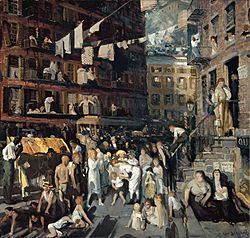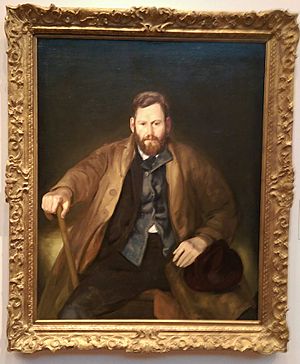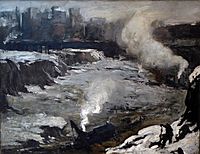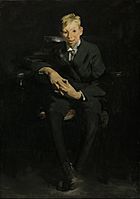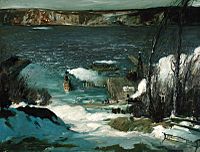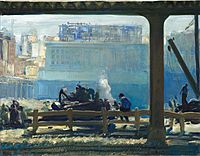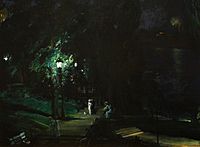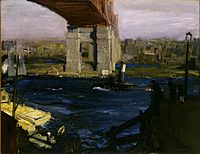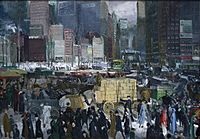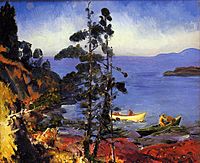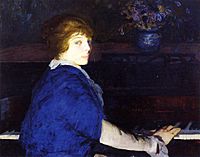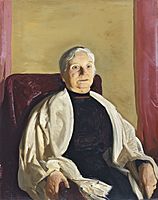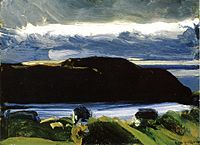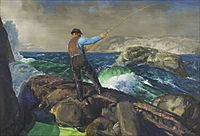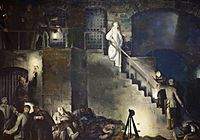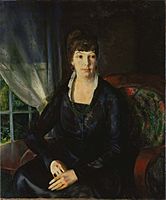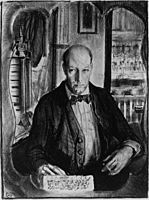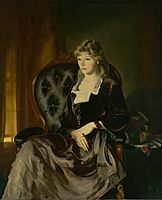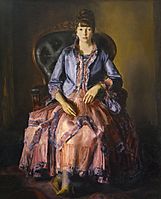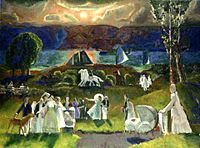George Bellows facts for kids
Quick facts for kids
George Bellows
|
|
|---|---|
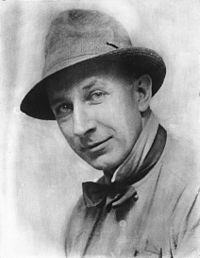 |
|
| Born |
George Wesley Bellows
August 12, or August 19, 1882 Columbus, Ohio, U.S.
|
| Died | January 8, 1925 (aged 42) New York City, New York, U.S.
|
| Nationality | American |
| Education | Robert Henri |
| Known for | Painting |
| Movement | Ashcan School The Eight American realism |
George Wesley Bellows (born August 12 or 19, 1882 – died January 8, 1925) was an American painter. He was known for his bold and realistic paintings of city life in New York. Many people thought he was the most important American artist of his time.
Contents
Early Life and Talents
George Wesley Bellows grew up in Columbus, Ohio. He was the only child of George and Anna Bellows. His mother's family came from Sag Harbor, New York, where they spent their summer holidays. George loved to draw from a very young age. His teachers often asked him to decorate their classrooms for holidays.
When he was 10, George also became very good at sports. He played baseball and basketball so well that he played semi-professional games for many years. A baseball scout even offered him a professional contract! But George chose to go to Ohio State University instead (from 1901 to 1904).
At Ohio State, he played sports and drew pictures for the school yearbook. Even though he had chances in sports and drawing for magazines, George really wanted to be a painter. His parents weren't sure about this choice. In 1904, just before he was supposed to graduate, he left Ohio State. He moved to New York City to study art.
Becoming an Artist in New York
In New York, George Bellows studied with a famous teacher named Robert Henri. Henri taught at the New York School of Art. While studying there, Bellows joined a group of artists called "The Eight" or the Ashcan School. These artists believed in painting everyday American life, showing things as they really were. By 1906, Bellows had his own art studio in New York City.
Bellows became well-known in 1908. He and other students of Robert Henri showed their paintings, mostly of city scenes. Some critics thought the paintings looked rough. But others found them exciting and new, even better than his teacher's work. Bellows started teaching at the Art Students League of New York in 1909. But he was more interested in becoming a successful painter. His fame grew as his art was shown in more important exhibitions.
Bellows' paintings of New York City showed the busy, sometimes messy, life of working-class people. He also made fun of the rich people. From 1907 to 1915, he painted many scenes of New York City covered in snow. These paintings showed a strong contrast between the bright snow and the rough city buildings. They made the hard work of clearing snow look almost beautiful.
However, Bellows is most famous for his paintings of amateur boxing matches. These paintings have dark backgrounds. The bright, strong brushstrokes of the boxers make them seem to move right off the canvas.
Art and Society
As Bellows became more famous, his life and art changed. He still painted his usual city scenes. But he also started getting requests to paint portraits of wealthy people in New York. He also began spending summers in Maine, painting beautiful scenes of the ocean and islands.
George Bellows cared a lot about society. He joined a group of artists and activists who believed strongly in individual rights. He taught at the first Modern School in New York. He also worked for a socialist magazine called The Masses, drawing many pictures for it starting in 1911.
However, Bellows sometimes disagreed with others at the magazine. He believed that artistic freedom was more important than any political ideas. He also publicly supported the U.S. joining World War I. In 1918, he made a series of prints and paintings. These showed terrible things that the Allies said Germany did during its invasion of Belgium. But Bellows also criticized the U.S. government. He didn't like how they stopped people from speaking out against the war.
Some artists said Bellows shouldn't paint war scenes because he hadn't seen them himself. Bellows famously replied that he didn't know if Leonardo da Vinci "had a ticket to paint the Last Supper!"
Later Years and Legacy
In his later years, Bellows painted more about home life. His wife and daughters became his favorite subjects. These paintings showed a new way of using color and design, different from his earlier, more energetic work.
The sea was another important subject for Bellows. He painted over 250 ocean scenes during his career. One important painting, The Fisherman (1917), shows his love for the sea.
Besides painting, Bellows also made many contributions to lithography. This is a type of printmaking. He helped make lithography a respected art form in the U.S. He even had a lithography press in his studio. He worked with a master printer to create over a hundred images between 1921 and 1924. Many museums, like the Amon Carter Museum of American Art, have large collections of his lithographs.
Bellows also drew pictures for many books, including some by the famous writer H.G. Wells.
In 1919, Bellows taught at the Art Institute of Chicago. From 1920, he spent almost half of each year in Woodstock, New York, where he built a home for his family. George Bellows died on January 8, 1925, in New York City. He was only 42 years old. He died from an infection after his appendix burst. He was survived by his wife, Emma, and his two daughters, Anne and Jean. He is buried in Green-Wood Cemetery in Brooklyn.
Today, you can find George Bellows' paintings and prints in many major art museums across America. These include the National Gallery of Art in Washington, D.C., and the Whitney Museum of American Art in New York. The Columbus Museum of Art in his hometown also has many of his portraits and city scenes. In 2007, the White House bought his 1919 painting Three Children, which is now displayed there.
In 2013, a big exhibition of his art was held in London. In 2021, the Columbus Museum of Art opened the George Bellows Center. This center helps people study and learn more about his life and work.
Selected Works
-
Pennsylvania Station Excavation (1907). Brooklyn Museum
-
Frankie, the Organ Boy (1907) Nelson-Atkins Museum of Art
-
North River (1908), Pennsylvania Academy of the Fine Arts
-
Summer Night, Riverside Drive (1909) Columbus Museum of Art
-
The Bridge, Blackwell's Island (1909) Toledo Museum of Art
-
The Fisherman (1917), Amon Carter Museum of American Art
-
Edith Cavell (1918)
-
Three Children (1919) White House Art Collection
Images for kids
See also
 In Spanish: George Wesley Bellows para niños
In Spanish: George Wesley Bellows para niños


